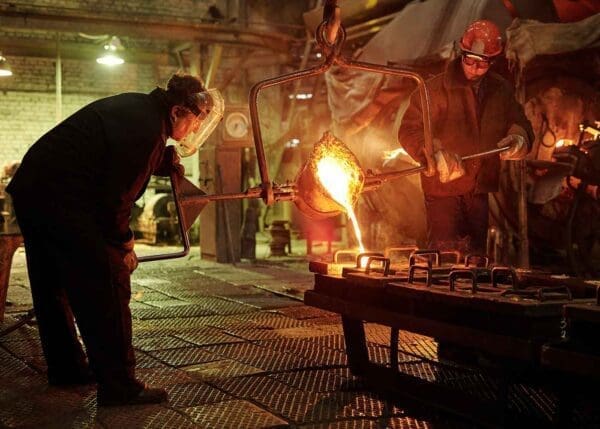01. Asbestos Use at Steel Mills
How Was Asbestos Used at Steel Mills?
Before the 1970s, asbestos was used in a variety of equipment at steel mills. Steel mill machinery and welding equipment used asbestos to improve heat resistance.
For example, asbestos insulation was incorporated into many products and machines. Asbestos insulation was a useful construction material because of its lightweight, durable and fireproof qualities.
During installation, maintenance and repair, asbestos insulation may have released asbestos dust. As a result, many steel mill workers inhaled airborne asbestos. Inhalation or ingestion may cause individuals to develop asbestos-related diseases.
Most steel mills stopped using asbestos products in the 1970s. However, old asbestos-containing materials may still be present at some steel mills.
This means some steelworkers may still be at risk of asbestos exposure from past use.
02. Notable Steel Mills
Notable Steel Mills That Used Asbestos
Steel mills across the country often used asbestos products. Asbestos companies frequently supplied steel mills with products such as asbestos insulation.
The use of asbestos by U.S. steel mills exposed many workers and their loved ones to asbestos. Some steel mills continue to remove asbestos and face the legal consequences of past use.
Bethlehem Steel Corporation
Bethlehem Steel Corporation was an American steel and shipbuilding company. The corporation supplied materials to the U.S. military and contributed steel for several large-scale projects, including the Golden Gate Bridge.
Before 1974, Bethlehem Steel used a variety of asbestos products for heat resistance. Steelworkers at the company said asbestos dust was commonly in the air at facilities.
Bethlehem Steel employees were often unaware of asbestos dangers and not given protective equipment. As a result, thousands of workers and nearby residents of Bethlehem Steel experienced asbestos exposure.
The company stopped using asbestos products in 1974. However, individuals exposed in the past may still develop an asbestos illness.
U.S. Steel Corp.
U.S. Steel Corp. was once North America’s biggest producer of raw steel. For decades, the company used asbestos products in its steel mills.
Steelworkers at U.S. Steel facilities frequently worked with asbestos-containing materials. Workers also wore asbestos clothing while working at the company’s mills.
Although U.S. Steel no longer uses asbestos products, the company was recently fined for putting employees at risk. In 2016, the Occupational Health and Safety Administration (OSHA) fined U.S. Steel $170,000 for exposing employees to asbestos.
The company continues to face asbestos lawsuits from individuals who experienced asbestos exposure at U.S. Steel facilities.
Other Steel Mills That Caused Exposure
Steel mills and other companies in the steel industry that have had proven exposure to asbestos across the United States include:
03. Who Is at Risk?
Who Is at Risk of Exposure at Steel Mills?
Steel mill workers risked occupational asbestos exposure from asbestos-containing materials at work. Asbestos was commonly added to steel mill equipment to protect it from high heat.
A variety of occupations at steel mills handled asbestos products. While handling these products, asbestos fibers often became airborne and could be inhaled or ingested.
Many workers were unaware of the dangers of asbestos. Additionally, steelworkers were often not given face masks or other clothing to protect them from asbestos dust.
All steelworkers who worked with or around asbestos products may have experienced exposure. Some workers may still be at risk of exposure from old equipment.
Steel mill workers were also at risk of asbestos exposure from their clothing. Steelworkers often wore asbestos clothing to protect them from hot steel. Protective clothing included:
- Coats
- Coveralls
- Aprons
- Gloves
- Pants
Asbestos clothing could be dangerous after heavy use, damage or misuse. These conditions could disturb asbestos fibers within the clothing. Although the clothing was designed to protect workers from heat, it put them at high risk of asbestos exposure.
The families of steelworkers were also at risk of asbestos exposure. Loved ones of the workers may have experienced secondary asbestos exposure when fibers were brought home on clothing.
Direct asbestos exposure and secondary exposure put individuals in danger. Asbestos exposure may lead to mesothelioma, lung cancer, asbestosis and other asbestos-related diseases.
04. Asbestos Lawsuits
Asbestos Lawsuits and Compensation
Current and former steelworkers diagnosed with mesothelioma or another asbestos-related disease may seek financial compensation. Steelworkers who experienced occupational asbestos exposure can file an asbestos lawsuit against negligent asbestos companies.
Successful lawsuits may result in a mesothelioma settlement or verdict. Compensation may help individuals pay for treatment and other expenses.
In some cases, individuals may also file an asbestos trust fund claim. Some asbestos companies have established asbestos trust funds to compensate successful claimants.
Steelworkers with mesothelioma or another asbestos illness can contact a lawyer to learn about their compensation options. An experienced mesothelioma lawyer can help victims and their loved ones understand the best options for their situation.




